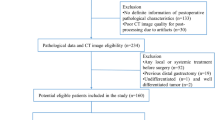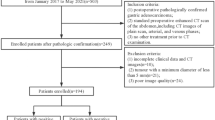Abstract
Objectives
To determine whether multiphasic dynamic CT can preoperatively predict lymphovascular invasion (LVI) in advanced gastric cancer (AGC).
Methods
278 patients with AGC who underwent preoperative multiphasic dynamic CT were retrospectively recruited. Tumour CT attenuation difference between non-contrast and arterial (ΔAP), portal (ΔPP) and delayed phase (ΔDP), tumour-spleen attenuation difference in the portal phase (ΔT-S), tumour contrast enhancement ratios (CERs), tumour-to-spleen ratio (TSR) and tumour volumes were obtained. All CT-derived parameters and clinicopathological variables associated with LVI were analysed by univariate analysis, followed by multivariate and receiver operator characteristics (ROC) analysis. Associations between CT predictors for LVI and histopathological characteristics were evaluated by the chi-square test.
Results
ΔPP (OR, 1.056; 95% CI: 1.032–1.080) and ΔT-S (OR, 1.043; 95% CI: 1.020–1.066) are independent predictors for LVI in AGC. ΔPP, ΔT-S and their combination correctly predicted LVI in 74.8% (AUC, 0.775; sensitivity, 88.6%; specificity, 54.1%), 68.7% (AUC, 0.747; sensitivity, 68.3%; specificity, 69.4%) and 71.7% (AUC, 0.800; sensitivity, 67.6%; specificity, 77.8%), respectively. There were significant associations between CT predictors for LVI with tumour histological differentiation and Lauren classification.
Conclusion
Multiphasic dynamic CT provides a non-invasive method to predict LVI in AGC through quantitative enhancement measurement.
Key points
• Lymphovascular invasion rarely can be evaluated preoperatively in advanced gastric cancer (AGC).
• Δ PP and Δ T-S were independent predictors for LVI in patients with AGC.
• Δ PP and Δ T-S showed acceptable predictive performance for LVI.
• Combination of Δ PP and Δ T-S improved predictive performance for LVI.
• Multiphasic dynamic CT may be a useful adjunct for detecting LVI preoperatively.


Similar content being viewed by others
Explore related subjects
Discover the latest articles and news from researchers in related subjects, suggested using machine learning.Abbreviations
- AGC:
-
Advanced gastric cancer
- AUC:
-
Area under the curve
- CEA:
-
Carcinoembryonic antigen
- CER:
-
Contrast enhancement ratio
- GTV:
-
Gross tumour volume
- HU:
-
Hounsfield unit
- ICC:
-
Intraclass correlation coefficient
- NPV:
-
Negative predictive value
- PPV:
-
Positive predictive value
- ROC:
-
Receiver operator characteristics
- ROI:
-
Region of interest
- TSR:
-
Tumour-to-spleen ratio
References
Songun I, Putter H, Kranenbarg EM, Sasako M, van de Velde CJ (2010) Surgical treatment of gastric cancer: 15-year follow-up results of the randomised nationwide Dutch D1D2 trial. Lancet Oncol 11:439–449
Komori M, Asayama Y, Fujita N et al (2013) Extent of arterial tumor enhancement measured with preoperative MDCT gastrography is a prognostic factor in advanced gastric cancer after curative resection. AJR Am J Roentgenol 201:W253–W261
Ahmad R, Setia N, Schmidt BH et al (2016) Predictors of Lymph Node Metastasis in Western Early Gastric Cancer. J Gastrointest Surg 20:531–538
Li P, He HQ, Zhu CM et al (2015) The prognostic significance of lymphovascular invasion in patients with resectable gastric cancer: a large retrospective study from Southern China. BMC Cancer 15:370
Talamonti MS, Kim SP, Yao KA et al (2003) Surgical outcomes of patients with gastric carcinoma: the importance of primary tumor location and microvessel invasion. Surgery 134:720–727
Dicken BJ, Graham K, Hamilton SM et al (2006) Lymphovascular Invasion Is Associated With Poor Survival in Gastric Cancer. Ann Surg 243:64–73
Maehara Y, Kabashima A, Koga T et al (2000) Vascular invasion and potential for tumor angiogenesis and metastasis in gastric carcinoma. Surgery 128:408–416
Padera TP, Kadambi A, di Tomaso E et al (2002) Lymphatic metastasis in the absence of functional intratumor lymphatics. Science 296:1883–1886
Kikuchi E, Margulis V, Karakiewicz PI et al (2009) Lymphovascular invasion predicts clinical outcomes in patients with node-negative upper tract urothelial carcinoma. J Clin Oncol 27:612–618
Chou CT, Chen RC, Lee CW, Ko CJ, Wu HK, Chen YL (2012) Prediction of microvascular invasion of hepatocellular carcinoma by pre-operative CT imaging. Br J Radiol 85:778–783
Kim SH, Kim CS, Kim MJ, Cho JY, Cho SH (2016) Differentiation of clear cell renal cell carcinoma from other subtypes and fat-poor angiomyolipoma by use of quantitative enhancement measurement during three-phase MDCT. Am J Roentgenol 206:W21–W28
Lee-Felker SA, Felker ER, Tan N et al (2014) Qualitative and Quantitative MDCT Features for Differentiating Clear Cell Renal Cell Carcinoma From Other Solid Renal Cortical Masses. Am J Roentgenol 203:W516–W524
Tsurumaru D, Miyasaka M, Nishimuta Y et al (2015) Differentiation of early gastric cancer with ulceration and resectable advanced gastric cancer using multiphasic dynamic multidetector CT. Eur Radiol 26:1330–1337
Yin XD, Huang WB, Lu CY, Zhang L, Wang LW, Xie GH (2011) A preliminary study on correlations of triple-phase multi-slice CT scan with histological differentiation and intratumoral microvascular/lymphatic invasion in gastric cancer. Chin Med J (Engl) 124:347–351
Kim HJ, Kim AY, Oh ST et al (2005) Gastric cancer staging at multi-detector row CT gastrography: comparison of transverse and volumetric CT scanning. Radiology 236:879–885
Rockall AG, Sohaib SA, Evans D et al (2003) Hepatic steatosis in Cushing's syndrome: a radiological assessment using computed tomography. Eur J Endocrinol 149:543–548
Lauren P (1965) The two histological main types of gastric carcinoma: Diffuse and so-called intestinal-type carcinoma. An attempt at a histo-clinical classification. Acta Pathol Microbiol Scand 64:31–49
Liang YX, Deng JY, Guo HH et al (2013) Characteristics and prognosis of gastric cancer in patients aged >/= 70 years. World J Gastroenterol 19:6568–6578
Busing KA, Kilian AK, Schaible T, Debus A, Weiss C, Neff KW (2008) Reliability and validity of MR image lung volume measurement in fetuses with congenital diaphragmatic hernia and in vitro lung models. Radiology 246:553–561
Holopainen T, Bry M, Alitalo K, Saaristo A (2011) Perspectives on lymphangiogenesis and angiogenesis in cancer. J Surg Oncol 103:484–488
Tomoda M, Maehara Y, Kakeji Y, Ohno S, Ichiyoshi Y, Sugimachi K (1999) Intratumoral neovascularization and growth pattern in early gastric carcinoma. Cancer 85:2340–2346
Maehara Y, Kakeji Y, Oda S, Baba H, Sugimachi K (2001) Tumor growth patterns and biological characteristics of early gastric carcinoma. Oncology 61:102–112
Kim H, Park MS, Choi JY et al (2009) Can microvessel invasion of hepatocellular carcinoma be predicted by pre-operative MRI? Eur Radiol 19:1744–1751
Yao J, Yang ZG, Chen TW, Li Y, Yang L (2010) Perfusion changes in gastric adenocarcinoma: evaluation with 64-section MDCT. Abdom Imaging 35:195–202
Satoh A, Shuto K, Okazumi S et al (2010) Role of perfusion CT in assessing tumor blood flow and malignancy level of gastric cancer. Dig Surg 27:253–260
Sun ZQ, Cheng XF, Ge YX et al (2015) Role of CT perfusion imaging in patients with variously differentiated gastric adenocarcinoma. J Xray Sci Technol 23:737–744
Zongqiong S, Xiaohong L, Wei C et al (2016) CT perfusion imaging of the stomach: a quantitative analysis according to different degrees of adenocarcinoma cell differentiation. Clin Imaging 40:558–562
Sieren JC, Ohno Y, Koyama H, Sugimura K, McLennan G (2010) Recent technological and application developments in computed tomography and magnetic resonance imaging for improved pulmonary nodule detection and lung cancer staging. J Magn Reson Imaging 32:1353–1369
Dong Y, Lei GW, Wang SW, Zheng SW, Ge Y, Wei FC (2014) Diagnostic value of CT perfusion imaging for parotid neoplasms. Dentomaxillofac Radiol 43:20130237
Lee SM, Kim SH, Lee JM et al (2009) Usefulness of CT volumetry for primary gastric lesions in predicting pathologic response to neoadjuvant chemotherapy in advanced gastric cancer. Abdom Imaging 34:430–440
Mori N, Mugikura S, Takasawa C et al (2016) Peritumoral apparent diffusion coefficients for prediction of lymphovascular invasion in clinically node-negative invasive breast cancer. Eur Radiol 26:331–339
Acknowledgements
The scientific guarantor of this publication is Zaiyi Liu. The authors of this manuscript declare no relationships with any companies whose products or services may be related to the subject matter of the article.
This study received funding from the National Natural Scientific Foundation of China (No. 81271569, No. 81601469 and NO.U1301258).
No complex statistical methods were necessary for this paper. Institutional Review Board approval was obtained. Written informed consent was waived by the Institutional Review Board. Study subjects or cohorts have not been previously reported. Methodology: retrospective diagnostic study, performed at one institution.
Author information
Authors and Affiliations
Corresponding author
Additional information
Zelan Ma and Changhong Liang contributed equally to this work.
Rights and permissions
About this article
Cite this article
Ma, Z., Liang, C., Huang, Y. et al. Can lymphovascular invasion be predicted by preoperative multiphasic dynamic CT in patients with advanced gastric cancer?. Eur Radiol 27, 3383–3391 (2017). https://doi.org/10.1007/s00330-016-4695-6
Received:
Revised:
Accepted:
Published:
Issue Date:
DOI: https://doi.org/10.1007/s00330-016-4695-6




